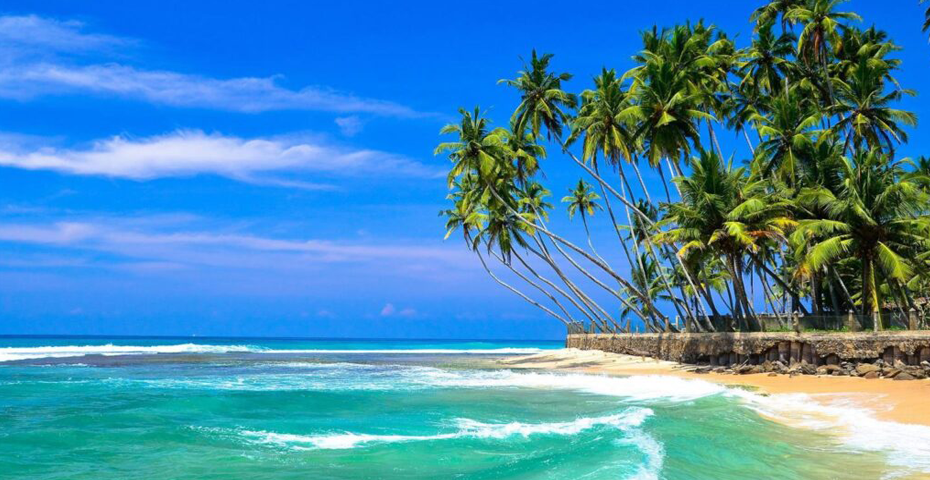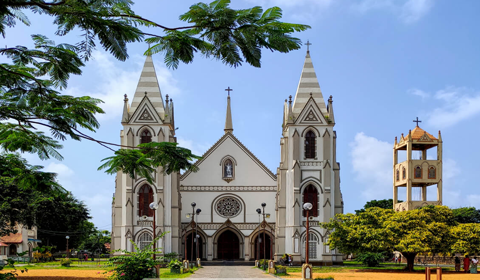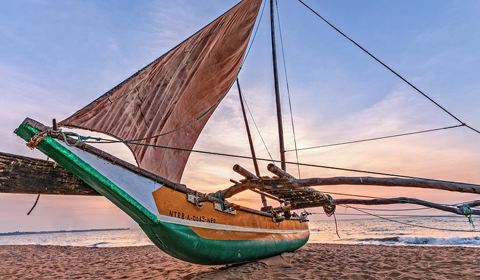
Negombo
Negombo (Sinhala: මීගමුව [ˈmiːɡamuʋə]; Tamil: நீர்கொழும்பு [nir koɭumbu]) is a major city in Sri Lanka, located on the west coast of the island and at the mouth of the Negombo Lagoon, in Western Province, Sri Lanka. Negombo is the fifth largest city in the country after the capital Colombo, Kandy, Jaffna and Galle, and it is the second largest city in Western province after Colombo. Negombo is also the administrative capital of Negombo Division. It is one of the major commercial hubs in Sri Lanka of about 128,000 inhabitants in the city limits, approximately 35 km north of Colombo city. Negombo is known for its huge and old fishing industry with busy fish markets and sandy beaches.
Etymology
The name “Negombo” was first used by the Portuguese ; the Sinhala name Mīgamuva (මීගමුව), means the “Group of Bees”, has been named a few centuries ago in the ancient kings’ era. The squad of king Kavantissa, found out the bee honey on a canoe near the seashore of this place, for Viharamahadevi, was pregnant for the prince Dutugamunu, then the place has been named as “Mee-Gomuwa”.
Economy
Negombo is about 5-6 km from the Bandaranaike International Airport and Negombo has a moderate fish port (used during the periods of Portuguese and Dutch colonization)
The economy of Negombo is mainly based on tourism and its centuries-old fishing industry, though it also produces cinnamon,ceramics, and brass ware.
The Colombo Stock Exchange-Negombo branch and many major financial corporations have their key branches in Negombo. There are also Departmental stores, Large super markets, and various Boutiques in the bustling streets of Negombo downtown and various other stores and international food outlets being opened.
History
The wild cinnamon that grew in the region around Negombo was said to be “the very best in the universe as well as the most abundant” and for centuries attracted a succession of foreign traders and colonial powers. The shallow waters of the Negombo Lagoon provided safe shelter for seafaring vessels and became one of the key ports (along with Kalpitiya, Puttalam, Salavata, Kammala, Colombo, Kalutara, Beruwala and Galle) from which the Singhalese kingdoms conducted external trade.
The first Muslim Arabs (the Moors) arrived in Ceylon in the seventh and eighth centuries and eventually came to dominate the east-western trade routes. Many chose to settle in the coastal areas and their legacy can be seen today; their descendants the Sri Lankan Moors remain the largest minority group in Negombo. The Moors’ long held monopoly over the cinnamon trade, and the circuitous and largely overland route by which it was transported to Europe and the Mediterranean added greatly to its cost and encouraged a Portuguese takeover in the late fifteenth and early sixteenth century.
Landing in the early 1500s, the Portuguese ousted the Moors, constructed a fort in Negombo and took over the trade of cinnamon to the West. It was during the Portuguese occupation that the Karawa, or traditional fishing clan of Negombo embraced Catholicism almost without exception. So successfully were they converted that today Negombo is sometimes known as ‘Little Rome’ and nearly two thirds of its population profess a Catholic faith.
The Portuguese restructured the traditional production and management of cinnamon and maintained their control over the trade for more than a century. The decline of their power began in the 1630s when warfare between the Portuguese and the Kingdom of Kandy reached a stalemate and the King of Kandy turned to the Dutch for help.The Dutch captured Negombo from the Portuguese in 1646 and negotiated an armistice with Portugal for ten years. During this period of time the King of Kandy sought to provoke conflict between both nations by passing through the territories of the one to attack the other. On one occasion he captured the fort of Negombo and send the head of the Dutch commander Adrian Vander Stell to his countrymen in Galle.Although the Dutch managed to regain control of Negombo from the King by diplomatic means, hostilities continued. In particular the disruption of the cinnamon trade was a favourite method of the King to harass the Dutch.The legacy of the Dutch colonial era can be seen in the Dutch Fort, constructed in 1672, a number of other buildings and the extensive canal system that runs 120 km from Colombo in the South, through Negombo to Puttalam in the north.
Throughout the eighteenth century the demand for cinnamon from Ceylon outstripped the supply and the quality of cinnamon appears to have suffered. Other factors, including the continued hostility from the Kandian Government and a rival cinnamon trade from China led to a 40% decline in the volume of cinnamon exported between 1785 and 1791. Despite attempts to clear land around Negombo and create cinnamon plantations, by the time the British commander Colonel Stuart took over the trade in 1796, it was clear that the industry was in decline. Poor policies put in place by Frederick North the first Governor of British Ceylon exacerbated the problem and by the 1830s commercial interests had moved elsewhere.
Following the British takeover of the Kingdom of Kandy in 1815, Negombo lost its strategic value as an outpost of Colombo, however it continued to develop in commercial influence. The Negombo fishery was at the heart of the seafood trade in Ceylon and many migrant fisherman would arrive annually with the profits of their ventures going into the small but prosperous town. In 1907 Negombo was connected to the massive railway project that was linking the island together under British control and encouraging the growth of plantations in coconuts, tea and coffee.
Geography and Climate
Negombo city is about 2 meters above sea level and Negombo’s geography is a mix of land and water. The Dutch canal flow in the heart of the city of Negombo. The Negombo lagoon is one of the most scenic landmark of Negombo. There are over 190 species of wildlife and plenty of birds in mangroves of Negombo. The northern border of the city is formed by the Ma Oya river which meets the Indian Ocean.
Negombo features a tropical rainforest climate under the Köppen climate classification. The city receives rainfall mainly from southwestern monsoons from May to August and October to January. During the remaining months of the year there is also a little precipitation due to Convective rains. The average annual precipitation is about 2400 millimetres. The average temperature varies 24 to 30 degrees Celsius and there are high humidity levels from February to April.
Local Government
Negombo Municipal Council governs the city of Negombo with a Mayor from the government, since 1950. Negombo’s Mayor and the council members are elected through the local government election held once in five years. There are twenty-nine wards within the Negombo municipal boundary and each is represented by an elected member, but at the moment there are only twenty-six members.
Negombo city Local Board began in 1878. After forty-four years, It became Urban District Council on the 1st Jan. 1922. Negombo celebrated its silver jubilee of its Urban council status, in grand style in Feb 1948, Their Royal highness the Duke and Dutchess of Glocester were the main patrons on the opening day of the celebrations. The Negombo urban council was offered the Municipal status on the 1st of January in 1950 under the municipal ordinance of 1865.
Negombo Lagoon
The fishermen who are based at the Negombo lagoon live in abject poverty in shanty thatch palm villages along the water’s edge. They rely mainly on their traditional knowledge of the seasons for their livelihood, using outrigger canoes carved out of tree trunks and nylon nets to bring in modest catches from September through till April.
Their boats are made in two distinct forms, oruvas (a type of sailing canoe) and paruvas (a large, man-powered catamaran fitted with kurlon dividers), and are said to have originated in the islands off the Mozambican coast; they were brought to Sri Lanka by Portuguese traders in the 17th century.
For generations the lagoon has provided the fishermen with a plentiful supply of crabs, shrimps, lobsters, cuttle fish and many of the native species of fish. The men are regularly forced to head out to the ocean to fish, often losing money in the chartering process. In recent years, the villagers have supplemented the income earned from fishing by collecting toddy, or palm sap, which is used to brew arrack.


Tourism
Negombo is a major tourist destination in Sri Lanka. This city is an ideal and liberal place with luxury, tropical life style, for those who want quick access to and from the country’s main international airport and also to the Colombo city. The 100 km long canal network running through the city is still used, and outrigger canoes and modern water-craft ply this route daily, for trade and tourist purposes. Still remains of colonization include the Dutch fort built in 1672, as well as centuries-old Portuguese and Dutch houses, Administrative buildings, Churches and the ceiling frescoes of St. Mary’s cathedral church.
Negombo is also home to the country’s second-largest fish market, also locally famous as being called the “Lellama (Lel-La-Ma)”, at the north end of the town’s lagoon. There are daily fish auctions, which give tourists a chance to meet the area’s fishermen, buy fish and even organise fishing trips into the lagoon and the ocean beyond. Other nearby attractions open to visitors include Muthurajawela Marshland, which is part of a 6,000-hectare (14,826-acre). The Protected mangroves of the Negombo lagoon, is home to over 190 species of wildlife.
Negombo offers one of the best beaches on the west coast of Sri Lanka, and draws tourists who stop over for a day on their way to or from the airport. Some quiet stretches of the beach are maintained by the tourist hotels, while others are always busy with fishermen and their equipment. Water-sports and diving are also popular among visitors, with a few well-preserved coral reefs and a 50-year-old shipwreck that can be seen in the distance also known as ‘Kudapaduwa’ ( Ku-Da-Paa-Du-We) that serves as an artificial reef for many varieties of fish. “Mora Wala” (Mo-Ra-Wa-La) and “Beach Park” of Negombo are also very interesting places among visitors.
There are also local handicrafts, batiks and jewellery boutiques on the beaches and the shops in the city.






